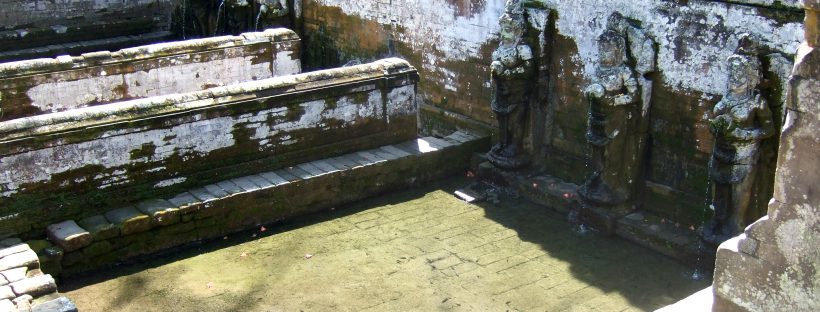Last updated on December 5th, 2018
Elephants are not native to Bali and the only ones found on the island today are at the Bali zoo. But if you are looking for stone elephants in a magical place, come to Goa Gajah, the Elephant Caves! Goa Gajah is located in Bedulu, a few kilometers outside Ubud in Central Bali. Here sculptures of Ganesha the elephant-headed Hindu god cohabit with Buddhist elements in a jungle and stone water garden.
The history of Goa Gajah has not yet been clearly established, but it seems that the cave and the lush surroundings have been a sacred site for a very long time, perhaps since the 9th century. One can easily understand why. The site sits in a beautiful location, on a stepped embankment above the confluence of the Pangkung and the Petanu rivers (the Petanu river is said to have been once called the Elephant river or Lwah Gajah).
The Elephant Cave itself opens out on an open space. The cave and monster’s mouth shaped entrance are carved into the rock. The monster rolls his menacing eyes at visitors, and his huge hands tear the rock apart creating the mouth-like cave entrance. All around him moss-covered animals and plants are engraved in the rock. It is quite an amazing sight. As you walk into the mouth, you are swallowed into the dark and damp cave. The atmosphere is quite peculiar in this small space, with people shuffling around in the semi-darkness and the near stagnant incense smoke. To the left as you enter stands a representation of Ganesha, and to the right, Shiva lingams with yonis. I am a bit claustrophobic, and usually don’t spend much time in here. I much prefer the outside of the cave and Goa Gajah’s surroundings.
In front of the Elephant Cave are two sunken pools. Six male and female stone figures poor water into the pools. Some people say that a seventh figure might have stood at the centre, between both pools. Perhaps you can piece one together from some of the excavated remains that are lined up on a side of the open space…?

Walk around the pools and bale (pavilions) and make your way to the river. Step through the candi bentar (split gates) besides the tall tree and follow the steps down to the river and forest. This is the real charm of visiting Goa Gajah. The river and forest are alive with sacred elements scattered along the paths: natural and man-made pools, small waterfalls, engraved rocks, sacred trees and small temples. The paved path soon gives way to a jungle trail, and you can either head back up to the car park or walk on to catch see carved stones and small shrines.
If you are ready for a bit of a jungle hike, the path leading up on the left along the river will eventually bring you to Yeh Puluh, a beautiful 14th century site with carvings along stone walls. The walk will take you through the jungle and then rice fields for a couple of kilometres (the path is not always very clear though) before ending up in the village of Tengkulak where you can easily ask for directions to Yeh Puluh.
Note : Goa Gajah is not accessible in a wheelchair or pram. From the car park above, it is a few minutes walk down steps (with handrail) to the main area in front of the Elephant Cave and the sunken pools. To visit the lush forest and get closer to the carved rocks along the river, it is another few minutes down concrete steps (not particularly steep, but no handrail). Jungle trails are unpaved. Kids are likely to enjoy Goa Gajah, especially the big carved monster face and looking out for small reliefs carved in the rocks along the river. Plus, the site is fairly small. Because of the steps, a baby / toddler carrier like a sarong or a backpack can be useful.
![]()
If you find our blog useful, please consider making a hotel or flight booking with our affiliate links. Happy travels!

